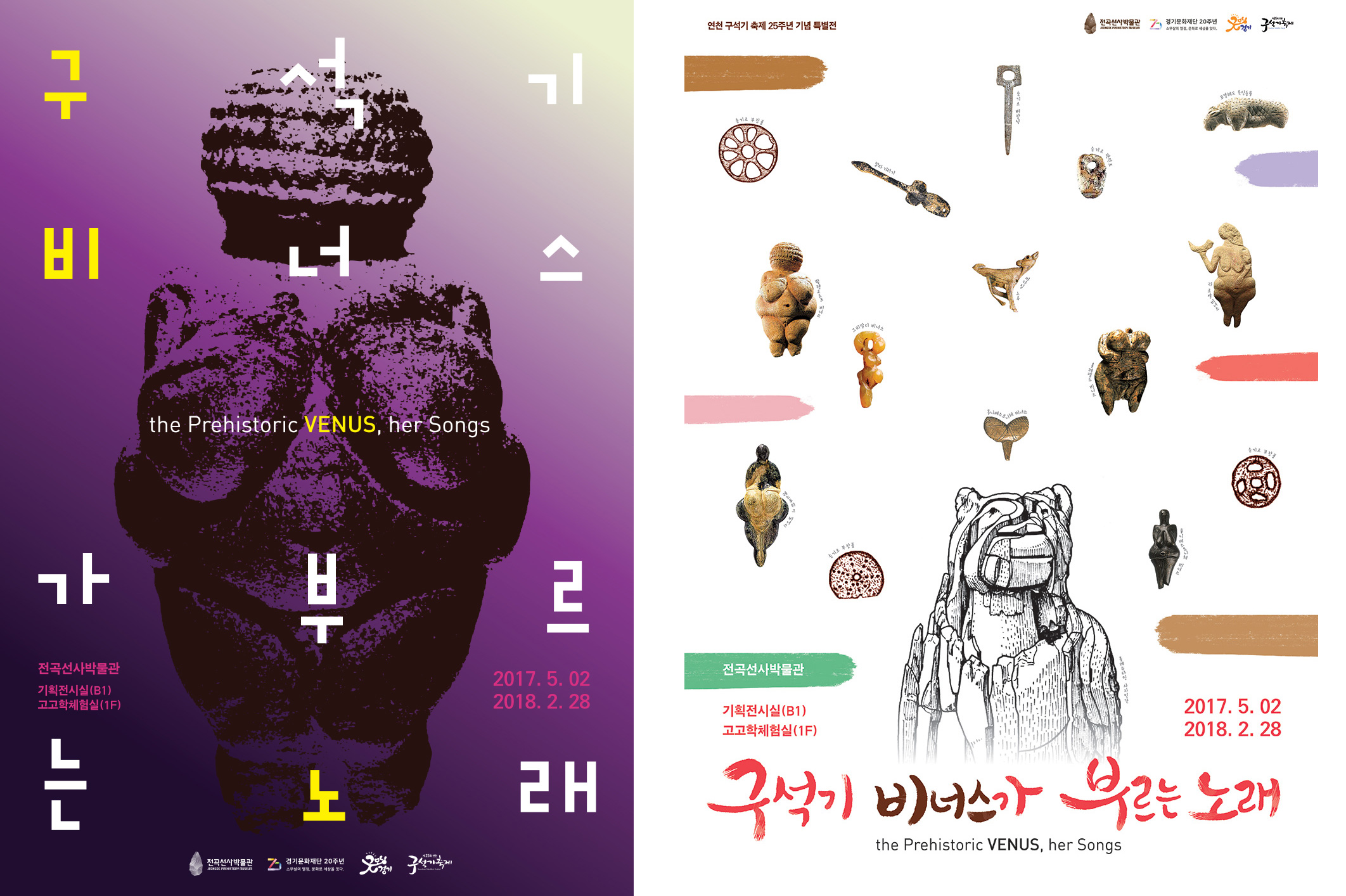《The Prehistoric VENUS, her Songs》 Special Exhibition Celebrating the 25th Anniversary of the Yeoncheon Paleolithic Festival
Period/ 2017.05.02(Tue) ~ 2018.02.28(Wed)
Overview
The Prehistoric VENUS, her Songs is about the art of the Upper Palaeolithic, which was part of the ice age. During the period, people survived harsh weather and made their art blossom using such materials as the ivory of mammoth, bones of animals, stone, and earth. Among others, they made numerous sculptures, especially the female form statues that we call ‘Venus’. They also left a large number of animal-shaped sculptures, as they cherished as their resources, objects of admiration, and companions living together in nature.
The Prehistoric VENUS, her Songs begins with wall drawings created with the theme of prehistoric art. In the first section, diverse types of Venus statues and animal sculptures are displayed with explanations of their creation and restoration processes. In the second section, you can find a variety of media arts and experience spaces.
The Prehistoric VENUS, her Songs begins with wall drawings created with the theme of prehistoric art. In the first section, diverse types of Venus statues and animal sculptures are displayed with explanations of their creation and restoration processes. In the second section, you can find a variety of media arts and experience spaces.
The Wall Art ‘Reborn Venus’

Artist Profile
Yu Seung-baek (XEVA)
Yu Seung-baek is a major artist who has made graffiti a kind of public art. He has been working on various wall art works, making them with ordinary citizens, at places like KIST and the Gyeonggi Museum of Modern Art. Reborn Venus is a 100-meter wall artwork, reinterpreting in a modern style a variety of the items displayed in the exhibition. Visitors can have a wonderful experience walking on the origin of human art.
Yu Seung-baek (XEVA)
Yu Seung-baek is a major artist who has made graffiti a kind of public art. He has been working on various wall art works, making them with ordinary citizens, at places like KIST and the Gyeonggi Museum of Modern Art. Reborn Venus is a 100-meter wall artwork, reinterpreting in a modern style a variety of the items displayed in the exhibition. Visitors can have a wonderful experience walking on the origin of human art.
Section 1.
A Time for the Blooming of Art
The hand axe that appeared 1.6 million years ago is evidence of the human brain and ability to use symbols, opening the first stage leading to art.

Hand Axe
The hand axe that appeared 1.6 million years ago is evidence of the human brain and ability to use symbols, opening the first stage leading to art.

Hand Axe
A Time for the Blooming of Art: Chronicle of the Venus
The buxom body of Venus, the iconic relic from the prehistoric age, is presumed to signify fecundity and prosperity, or to be used for rituals. The Venuses, made of various materials and having diverse shapes, were portable artwork for those living in the prehistoric period.

(L) Hohle Fels Venus
/ (R) Kostenki venus
The buxom body of Venus, the iconic relic from the prehistoric age, is presumed to signify fecundity and prosperity, or to be used for rituals. The Venuses, made of various materials and having diverse shapes, were portable artwork for those living in the prehistoric period.

(L) Hohle Fels Venus
/ (R) Kostenki venus
예술이 꽃피는 시간 : 동물상 연대기
구석기시대 인류에게 동물은 생존의 가장 중요한 자원이었다. 상아, 뼈, 흙, 돌 등 다양한 재료는 육식동물에서 초식동물까지 수많은 동물 조각상으로 재탄생되었다.

(L) Mas d’Azil Faon
/ (R) The lion head of Vogelherd
구석기시대 인류에게 동물은 생존의 가장 중요한 자원이었다. 상아, 뼈, 흙, 돌 등 다양한 재료는 육식동물에서 초식동물까지 수많은 동물 조각상으로 재탄생되었다.

(L) Mas d’Azil Faon
/ (R) The lion head of Vogelherd
A Time for the Blooming of Art: Chronicle of Animal Sculptures
It took around 70 years for modern scientists specializing in restoration to restore the ivory Lion Man, which was originally made by prehistoric men with more than 400 hours of labor. Its abstractness and meticulous process of design show the high level of prehistoric art.

Hohlenstein Lion Man
It took around 70 years for modern scientists specializing in restoration to restore the ivory Lion Man, which was originally made by prehistoric men with more than 400 hours of labor. Its abstractness and meticulous process of design show the high level of prehistoric art.

Hohlenstein Lion Man
Various Times for Art: Entombment Artifacts – And Life Continues
Prehistoric people decorated the deceased with delicate ornaments such as eyes or teeth of deer or ivory beads, and buried the person with various grave items. This gives a hint as to the perception of the prehistoric people regarding the afterlife and their ability to use symbols.

Prehistoric people decorated the deceased with delicate ornaments such as eyes or teeth of deer or ivory beads, and buried the person with various grave items. This gives a hint as to the perception of the prehistoric people regarding the afterlife and their ability to use symbols.

Section 2.
Enjoy various media arts and experiences and understand the skill of abstraction, the foundation of ‘art’, from the prehistoric to the modern age.
A Room of Archeologists Find out the secrets of art hidden here and there in the art media.
Chrome Music Lab KioskDraw with your hand, and listen to it! Experience the media drawing of ‘venus’s song’.

Drawing Kiosk
A Room of Archeologists Find out the secrets of art hidden here and there in the art media.
Chrome Music Lab KioskDraw with your hand, and listen to it! Experience the media drawing of ‘venus’s song’.

Drawing Kiosk
Comments [0]
Leave a comment
You must be logged in to post a comment.













